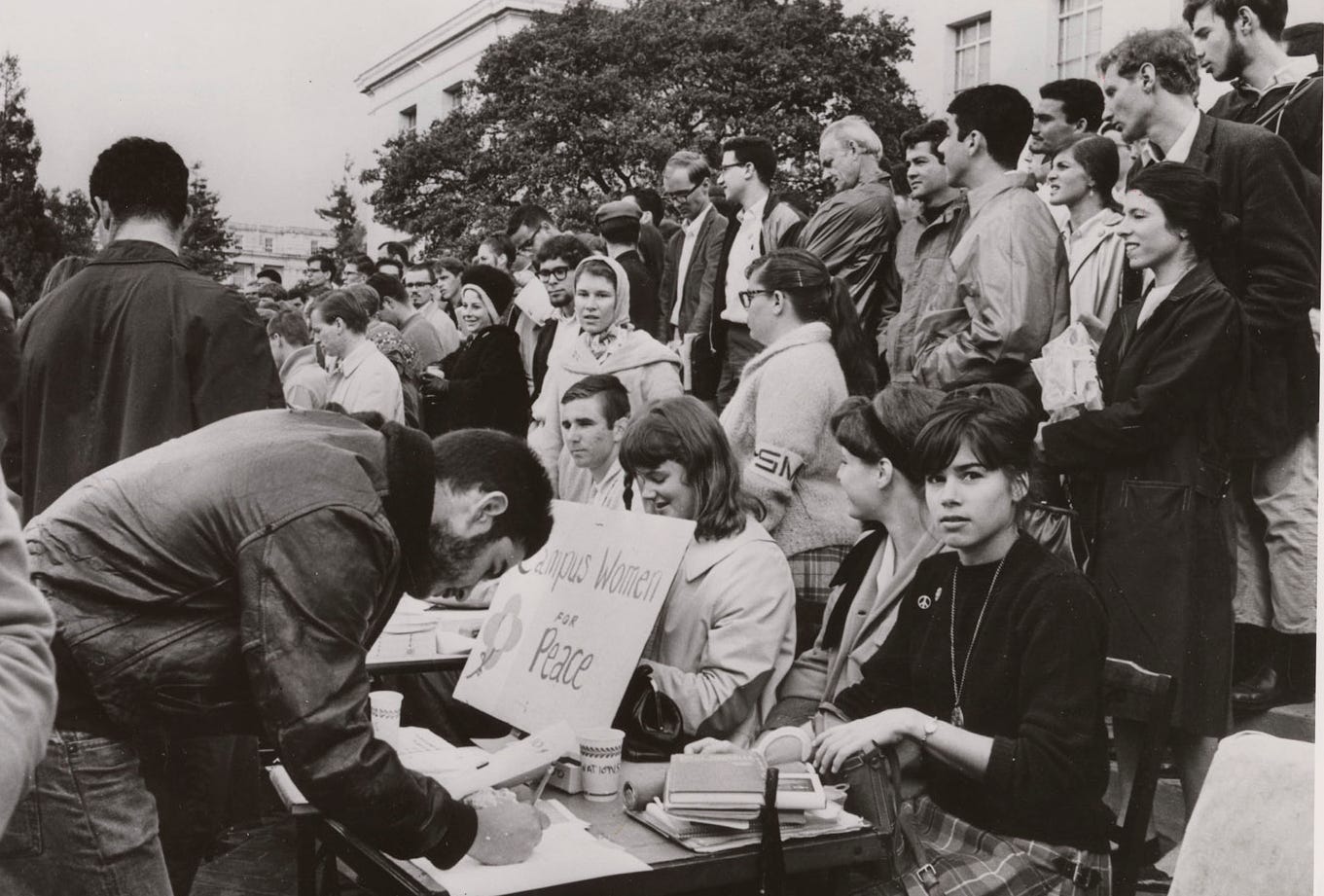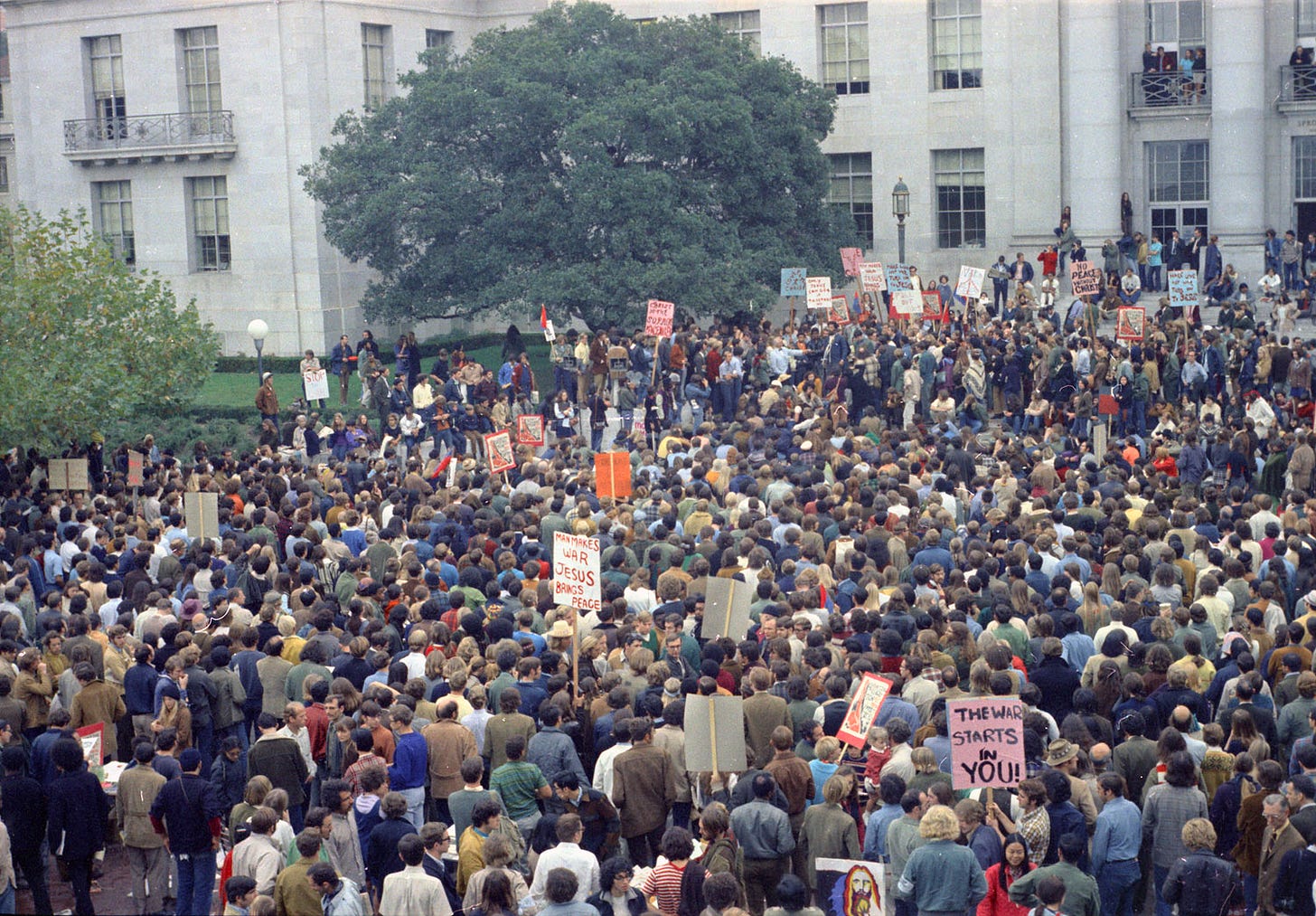“There’s a whole generation,
With a new explanation.”
San Francisco, by John Phillips, 1967
1968, tuned-in youth were rejecting the technocracy and distancing themselves from their middle-class parents. They saw the political system as in bed with technocracy, so fighting back through policy seemed pointless.
Even so, political activism is how some people engage in change, particularly students who remained enrolled in college.
Political action took place through campus-based organizations such as Students for a Democratic Society (SDS) and Youth International Party (“Yippies”). The news media then history set the term “campus radicals.” From his research on the counterculture, MIT professor David Kaiser describes the new left radical:
“The left-leaning hippie movement, for example, had an uneasy relationship with the ‘New Left,’ the campus-based liberal and increasingly radical political movement associated with the Students for a Democratic Society and (ultimately) the Weather Underground. Members of the New Left aimed at political intervention, inspired by the civil rights movement and stoked by the escalation of the Vietnam War.” (Kaiser 2011)
The counterculture had different branches: political radicals, on campus or not, were different from other hippies, who saw the individual as powerless against the machine of technocracy. Experiences in the Sixties gave them reasons to believe that political action resulted in little change, which was a major motivator to drop out during the Seventies.
“The campus radicals often looked with dismay on their hippie counterculture cousins, for whom political organizations of any stripe seem so very unhip.” (David Kaiser, 2011)

Tune in and drop out or activism?
Among the non-political hippies, some took a pacifist approach and dropped out of mainstream society. The back-to-the-land imperative was to reject the old and to start anew, to discover and create a new society based on values of love, freedom, respect for the natural world, and the rejection of modern materialism.
In The Making of a Counterculture, professor Roszak recognized that the young did want to grow up and be responsible, and their challenge was how to do this in a new paradigm.
“If you are twenty-five and have exhausted the dilatory possibilities of college and parental support… where is the life-sustaining receptacle that can nourish and protect good citizenship? … The answer is, you make up a community of those you love and respect, where there can be enduring friendships, children, and, by mutual aid, three meals a day scraped together by honorable and enjoyable labor. Nobody knows quite how it is to be done. There are not many reliable models. The old radicals are no help, they talked about socializing whole economies, or launching third parties, or strengthening the unions, but not about building communities.” (Roszak, 1968)
Get back to the land
The differentiation among hippies who moved to the country is an important distinction for this study, which concerns back-to-the-landers. Some who dropped out founded or joined communes which were often short-lived. The research culminates in an ethnography that reveals many back-to-the-landers continue homesteading into the new millennium, but they don’t call attention to themselves.
The counterculture movement exposed the problems in America during the Sixties that the status quo was reluctantly confronting: poverty, racism, war. Yet in the face of a power so much greater than the young, some became agitators and resorted to political agitation. By the close of the Sixties, those inclined to pacifism simply left the scene.
“Starting in the mid-1960s and on through the 1970s, each year thousands of urban émigrés found their way to the countryside to set up individual homesteads on a few acres of land… One student of the movement estimated that by the end of the 1970s, at the height of the urban-to-rural migration flows, there were over one million back-to-the-landers in rural North America, almost all on small acreages rather than living in communes or on large farms.” (Jacob, 1997)
The popular refrain was back to the garden. Return to the Garden of Eden, start over. Find a new way to live not driven by the pursuit of material goods or the Puritanical rules of the old guard, but focused instead on discovering and building a new kind of community that would bring them closer to nature and to each other.
References for this post:
Hoffman, David, 1991. Making Sense of the Sixties, PBS Video.
Jacob, Jeffrey, 1997. New Pioneers: The Back-to-the-Land Movement and the Search for a Sustainable Future.
Kaiser, David, 2011. How the Hippies Saved Physics: Science, Counterculture, and the Quantum Revival.
Phillips, John, 1967. San Francisco, The Mamas and the Papas. Produced by Lou Adler, released by Ode Records.
Roszak, Theodore, 1969. The Making of a Counterculture: Refections on the Technocratic Society and Its Youthful Opposition.
Up next: Communes: Birth and Rebirth








Fascinating! And presaging somewhat the regeneration movement now gaining new steam.